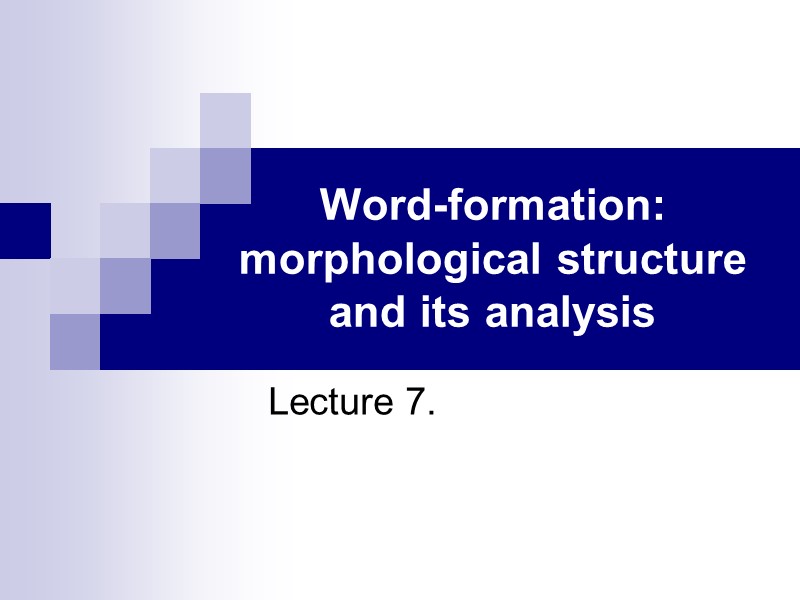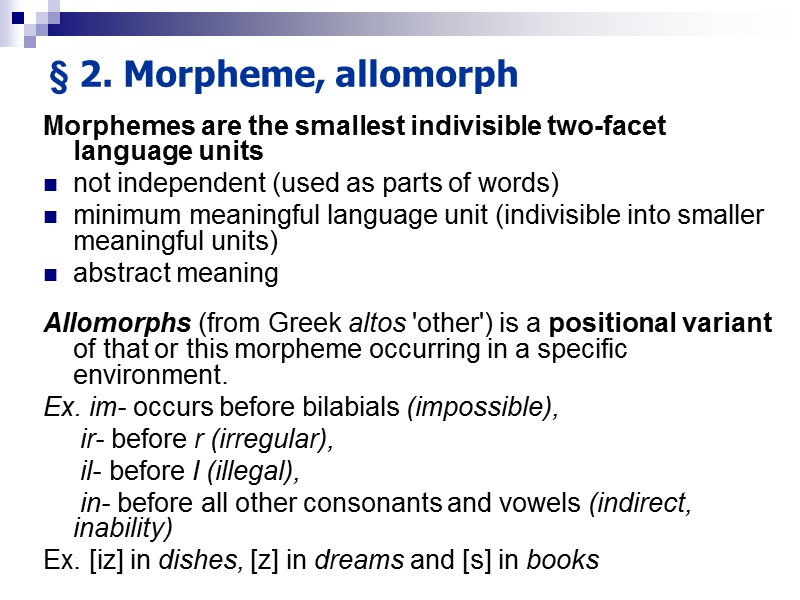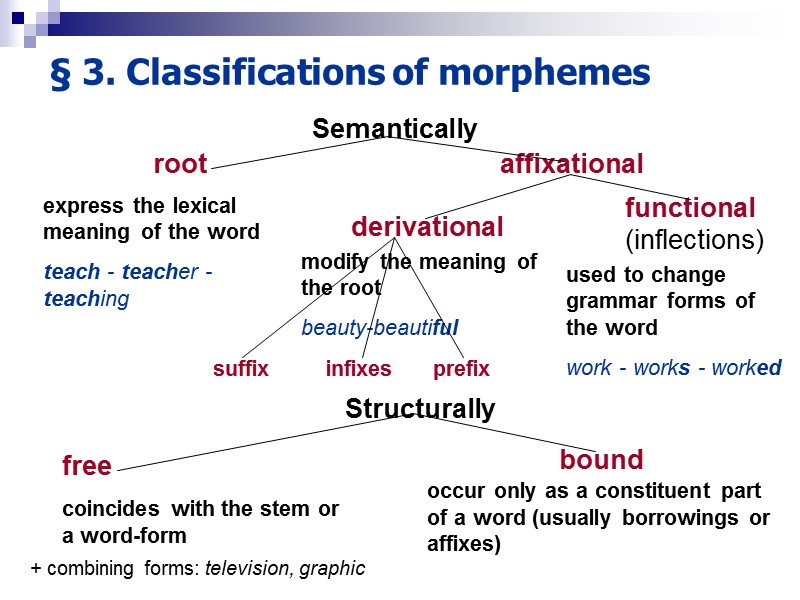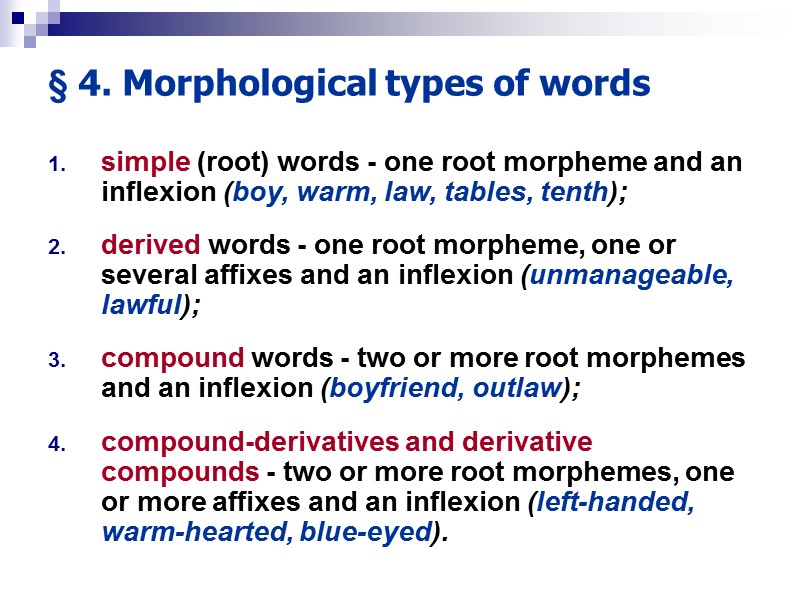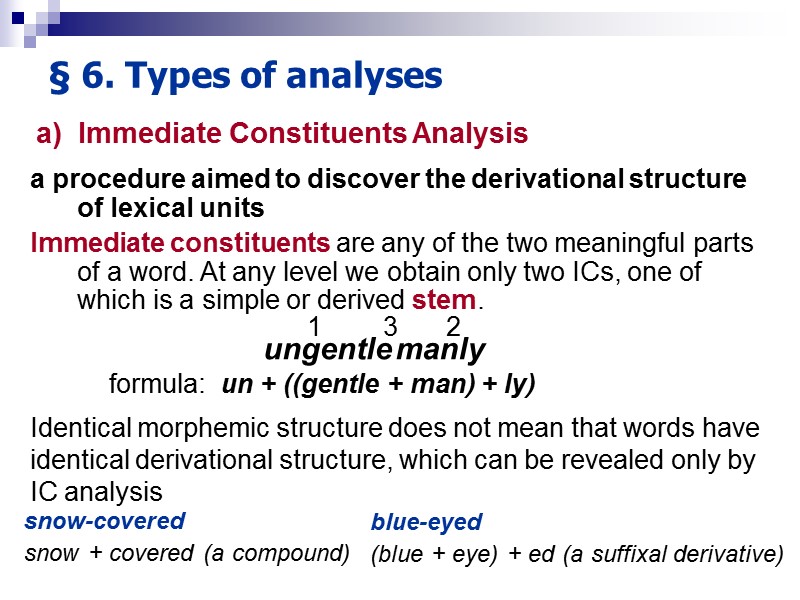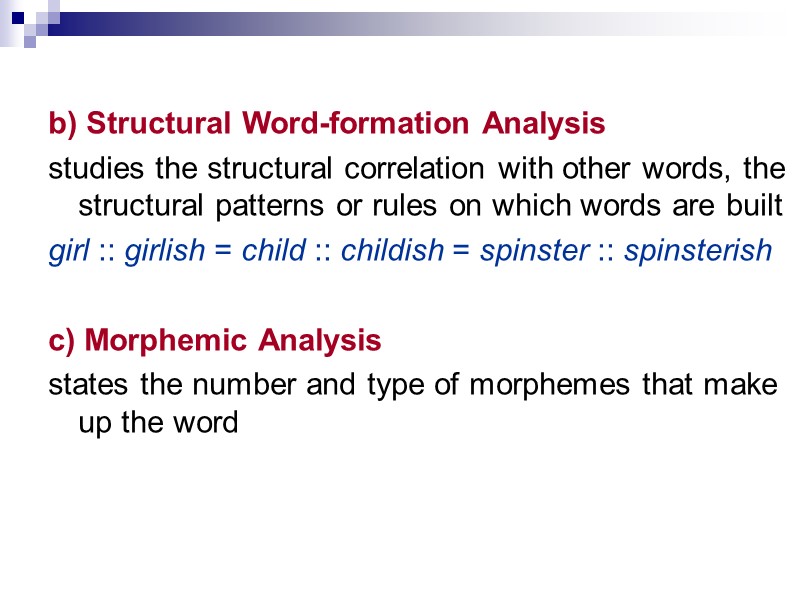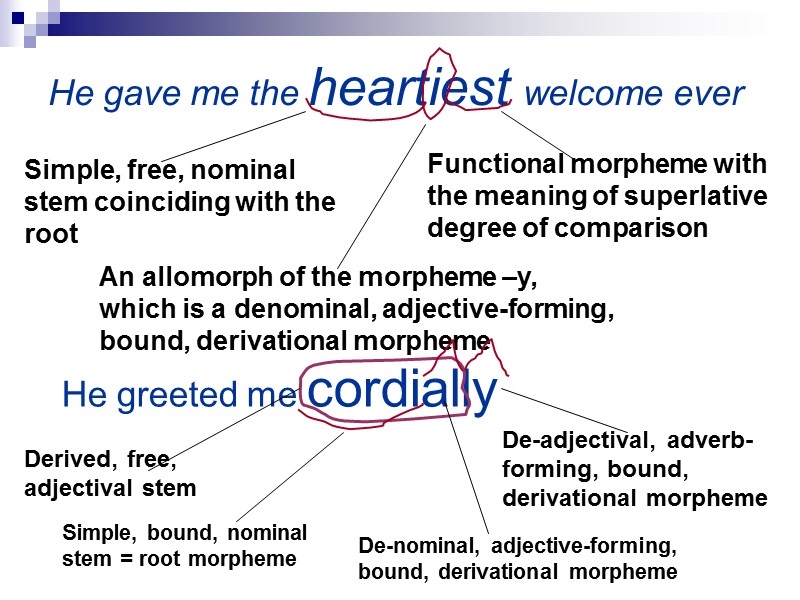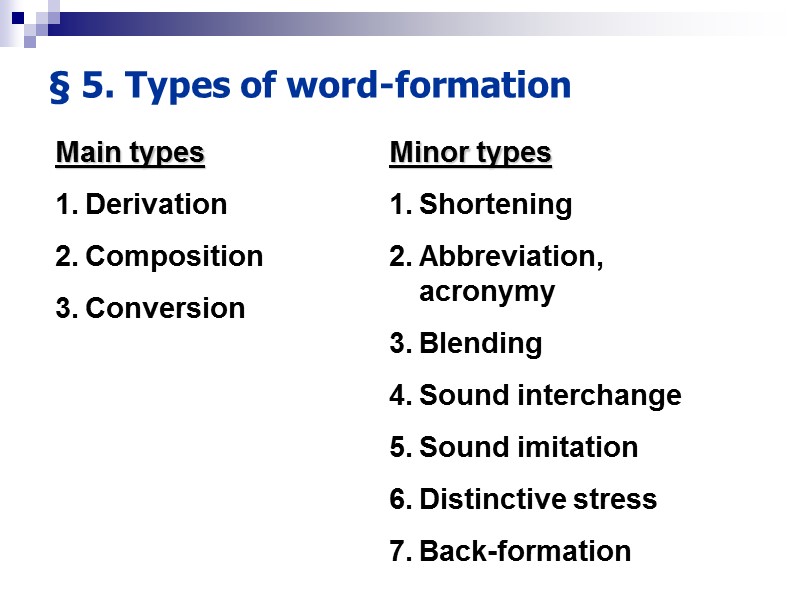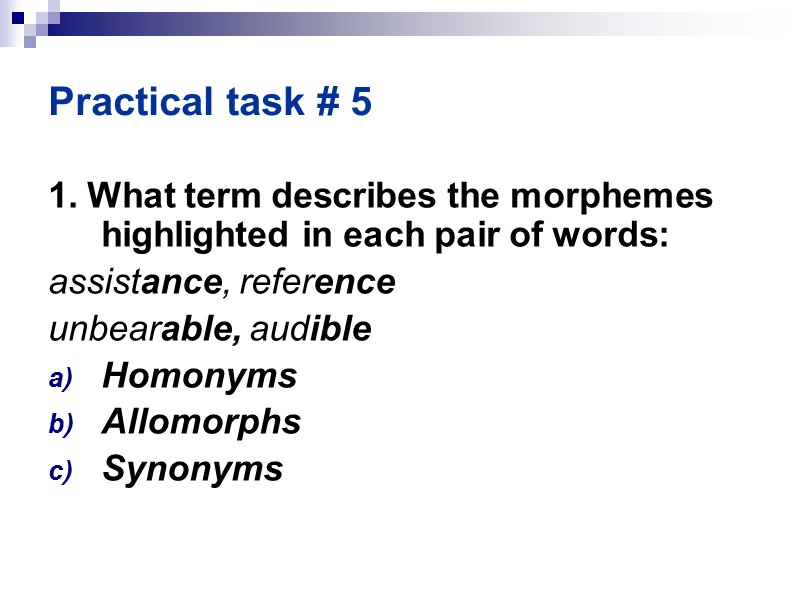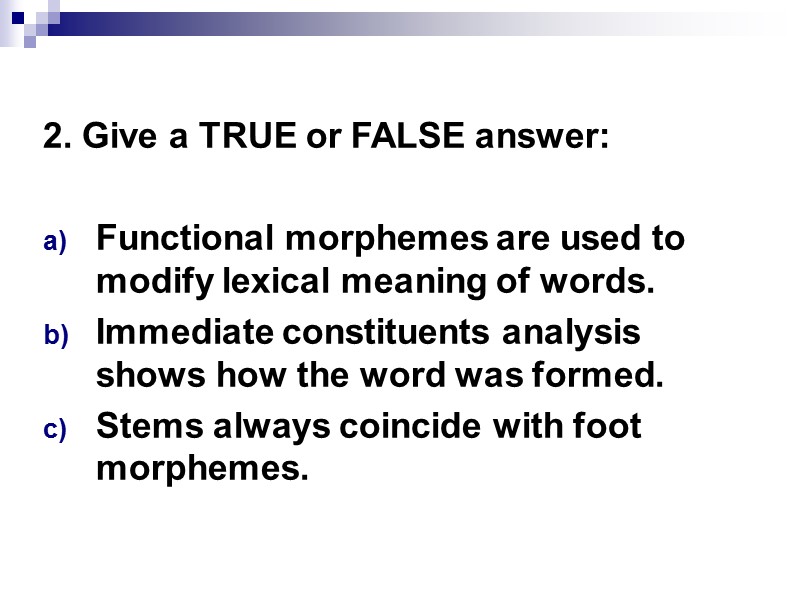Ic method
The
method is based on the fact that a word characterised by
morphological divisibility (analysable into morphemes) is involved in
certain
structural correlations.
Breaking
a word into its immediate constituents we observe in each cut the
structural order of the constituents (which may differ from their
actual sequence). Furthermore we shall obtain only two constituents
at each cut, the ultimate constituents, however, can be arranged
according to their sequence in the word: un-+gent-+-le+-man+’ly.
AIMS
AND PRINCIPLES OF MORPHEMIC AND WORD-FORMATION ANALYSIS
If
the analysis is limited to stating the number and type of morphemes
that make up the word, it is referred to as morphemic.
For
instance, the word girlishness
may
be analysed into three morphemes: the root -girl-
and
two suffixes -ish
and
-ness.
The
morphemic classification of words is as follows: one root morpheme —
a
root word (girl),
one
root morpheme plus one or more affixes —
a
derived word (girlish,
girlishness), two
or more stems —
a
compound word (girl-friend),
two
or more stems and a common affix —
a
compound derivative (old-maidish).
The
morphemic analysis establishes only the ultimate constituents
that make up the word.
A
structural
word-formation analysis
proceeds further: it studies the structural
correlation
with other words, the structural patterns or rules on which words are
built.
This
is done with the help of the principle of oppositions,
i.e.
by studying the partly similar elements, the difference between which
is functionally relevant; in our case this difference is sufficient
to create a new word. Girl
and
girlish
are
members of a morphemic opposition. They are similar as the root
morpheme -girl-
is
the same. Their distinctive feature is the suffix -ish.
Due
to this suffix the second member of the opposition is a different
word belonging to a different part of speech. This binary opposition
comprises two elements.
А
соrrelatiоn
is a set of binary oppositions. It is composed of two subsets formed
by the first and the second elements of each couple, i.e. opposition.
Each element of the first set is coupled with exactly one element of
the second set and vice versa. Each second element may be derived
from the corresponding first element by a general rule valid for all
members of the relation.
Observing
the proportional opposition:
girl
child woman monkey spinster book
girlish childish womanish monkeyish spinsterish bookish
it
is possible to conclude that there is in English a type of derived
adjectives consisting of a noun stem and the suffix -ish.
Observation
also shows that the stems are mostly those of animate nouns, and
permits us to define the relationship between the structural pattern
of the word and its meaning. Any one word built according to this
pattern contains a semantic component common to the whole group,
namely: ‘typical of, or having the bad qualities of. There are also
some other uses of the adjective forming ‘ish,
but
they do not concern us here.
In
the above example the results of morphemic analysis and the
structural
word-formation
analysis
practically
coincide.
There are other cases, however, where they are of necessity
separated. The morphemic analysis is, for instance, insufficient in
showing the difference between the structure of inconvenience
v
and impatience
n;
it classifies both as derivatives. From the point of view of
word-formation pattern, however, they are fundamentally different. It
is only the second that is formed by derivation. Compare:
impatience
n
=
patience
n
=
corpulence
n
impatient
a
patient
a
corpulent
a
The
correlation that can be established for the verb inconvenience
is
different, namely:
inconvenience
v
=
pain
v
=
disgust
v
=
anger
v
=
daydream
v
inconvenience
n
pain
n
disgust
n
anger
n
daydream
n
Here
nouns denoting some feeling or state are correlated with verbs
causing this feeling or state, there being no difference in stems
between the members of each separate opposition. Whether different
pairs in the correlation are structured similarly or differently is
irrelevant. Some of them are simple root words, others are
derivatives or compounds. In terms of word-formation we state that
the verb inconvenience
when
compared with the noun inconvenience
shows
relationships characteristic of the process of conversion. Cf.
to
position where
the suffix -tion
does
not classify this word as an abstract noun but shows it is derived
from one.
This
approach also affords a possibility to distinguish between compound
words formed by composition and those formed by other processes.
The words honeymoon
n
and honeymoon
v
are both compounds, containing
two free stems, yet the first is formed by composition: honey
n
+
moon
n
>
honeymoon
n,
and the second by conversion: honeymoon
n>
honeymoon
v
(see Ch. 8).
The
treatment remains synchronic because it is not the origin of the word
that is established but its present correlations in the vocabulary
and the patterns productive in present-day English, although
sometimes it is difficult to say which is the derived form.
Соседние файлы в предмете [НЕСОРТИРОВАННОЕ]
- #
- #
- #
- #
- #
- #
- #
- #
- #
- #
- #
Word-formation: morphological structure and its analysis Lecture 7.
§ 1. The grammar of lexicon When a word first comes into existence it is built out according to the existing patterns of the elements available in the language. Word-formation is that branch of lexicology that studies the derivative structure of existing words and the patterns on which a language builds new words. Words can be divided into smaller sense units which are generally referred to as morphemes (Greek morphe ‘form’ + -erne ‘the smallest distinctive unit’).
§ 2. Morpheme, allomorph Morphemes are the smallest indivisible two-facet language units not independent (used as parts of words) minimum meaningful language unit (indivisible into smaller meaningful units) abstract meaning Allomorphs (from Greek altos ‘other’) is a positional variant of that or this morpheme occurring in a specific environment. Ex. im- occurs before bilabials (impossible), ir- before r (irregular), il- before I (illegal), in- before all other consonants and vowels (indirect, inability) Ex. [iz] in dishes, [z] in dreams and [s] in books
§ 3. Classifications of morphemes Semantically root affixational express the lexical meaning of the word teach — teacher — teaching derivational functional (inflections) modify the meaning of the root beauty-beautiful used to change grammar forms of the word work — works — worked Structurally free coincides with the stem or a word-form bound occur only as a constituent part of a word (usually borrowings or affixes) suffix prefix infixes + combining forms: television, graphic
§ 4. Morphological types of words simple (root) words — one root morpheme and an inflexion (boy, warm, law, tables, tenth); derived words — one root morpheme, one or several affixes and an inflexion (unmanageable, lawful); compound words — two or more root morphemes and an inflexion (boyfriend, outlaw); compound-derivatives and derivative compounds — two or more root morphemes, one or more affixes and an inflexion (left-handed, warm-hearted, blue-eyed).
§ 6. Types of analyses a procedure aimed to discover the derivational structure of lexical units Immediate constituents are any of the two meaningful parts of a word. At any level we obtain only two ICs, one of which is a simple or derived stem. formula: un + ((gentle + man) + ly) 2 3 un gentle man ly Identical morphemic structure does not mean that words have identical derivational structure, which can be revealed only by IC analysis snow-covered snow + covered (a compound) blue-eyed (blue + eye) + ed (a suffixal derivative) a) Immediate Constituents Analysis 1
b) Structural Word-formation Analysis studies the structural correlation with other words, the structural patterns or rules on which words are built girl :: girlish = child :: childish = spinster :: spinsterish c) Mоrphemiс Analysis states the number and type of morphemes that make up the word
He gave me the heartiest welcome ever Simple, free, nominal stem coinciding with the root Functional morpheme with the meaning of superlative degree of comparison An allomorph of the morpheme –y, which is a denominal, adjective-forming, bound, derivational morpheme He greeted me cordially Derived, free, adjectival stem De-adjectival, adverb-forming, bound, derivational morpheme Simple, bound, nominal stem = root morpheme De-nominal, adjective-forming, bound, derivational morpheme
§ 5. Types of word-formation Main types Derivation Composition Conversion Minor types Shortening Abbreviation, acronymy Blending Sound interchange Sound imitation Distinctive stress Back-formation
Practical task # 5 1. What term describes the morphemes highlighted in each pair of words: assistance, reference unbearable, audible Homonyms Allomorphs Synonyms
2. Give a TRUE or FALSE answer: Functional morphemes are used to modify lexical meaning of words. Immediate constituents analysis shows how the word was formed. Stems always coincide with foot morphemes.
Скачать материал

Скачать материал




- Сейчас обучается 268 человек из 64 регионов


- Сейчас обучается 396 человек из 63 регионов


Описание презентации по отдельным слайдам:
-
1 слайд
Morphological Structure of English Words
-
2 слайд
The word as an autonomous unit of the language system should be distinguished from another fundamental language unit – the morpheme.
-
3 слайд
A morpheme
Is an association of a given meaning with a given sound pattern, which makes it similar to a word.
Unlike a word, a morpheme is not autonomous, morphemes occur in speech only as constituent parts of words.
Cannot be divided into smaller meaningful units, so it is defined as the minimum meaningful unit of the language system. -
4 слайд
According to their form
Morphemes
Free
Bound
Semi-bound
(semi-free) -
5 слайд
Free morphemes
Are capable of forming words without adding other morphemes, which means that they coincide with the stems or independent forms of words:
House- (morpheme) = house (word)
Shoe- (morpheme) = shoe (word)
Bread- (morpheme) = bread (word) -
6 слайд
Bound morphemes
May not stand alone without a loss or change of their meaning, they are always bound to something else. It means that they do not coincide with stems or independent forms of words:
Horr- (morpheme) – horr-or (word)
Agit- (morpheme) – agit-ate (word)
Nat- (morpheme) – nat-ion (word)
-Ible (morpheme) – elig-ible (word)
Pre- (morpheme) – pre-war (word) -
7 слайд
Free and Bound morphemes
Prefixes and suffixes (jointly called derivational affixes) are always bound
Root morphemes may be both free and bound
Bound root morphemes are mainly found among loan words: arrog-ance, char-ity, cour-age, dis-tort, in-volve, toler-able, etc. -
8 слайд
Semi-bound (semi-free) morphemes
Can function in a morphemic sequence both as an affix and as a free morpheme:
E.g., the morphemes «well» and «half» can occur as free morphemes (cf. sleep well, half an hour) or as bound morphemes (cf. well-known, half-done) -
9 слайд
According to their role in constructing words
Morphemes
Roots
Affixes -
10 слайд
According to their position in a word
Affixes
Prefixes
Suffixes
Infixes
(unproductive
in English) -
11 слайд
According to their function and meaning
Affixes
Derivational
Functional
(Endings,
inflexions) -
12 слайд
A stem
When a derivational or functional affix is stripped from the word, what remains is a stem (a stem base)
If a stem consists of a single morpheme, it is simple (heart, fact, month, red, etc.)
If a stem consists of a root and an affix, it is derived (hearty, factual, monthly, reddish, etc.)
If a stem consists of two root morphemes (and an affix / affixes), it is compound (teaspoon, mother-in-law, dog-owner, looking-glass, etc.) -
13 слайд
A root
Is the main morphemic vehicle of a given idea in a given language at a given stage of its development
Is the ultimate constituent element which remains after the removal of all functional and derivational affixes and does not admit any further analysis
Is the common element of words within a word-cluster (cf. heart, hearten, dishearten, heartily, heartless, hearty, heartiness, sweetheart, heart-broken, etc.) -
14 слайд
A root
The etymological treatment of root morphemes encourages a search for cognates (elements descended from a common ancestor):
Heart (English) – cor (Latin) – kardia (Greek) – corazon (Spanish) – Herz (German) – сердце (Russian), etc. -
15 слайд
A suffix
Is a derivational morpheme following the stem and forming a new derivative in a different part of speech or a different word class: luck – luck-y – luck-i-ly -
16 слайд
A prefix
Is a derivational morpheme standing before the root and modifying the meaning of the original word: happy – unhappy, president – ex-president, argument – counter-argument, etc. -
17 слайд
A prefix
Prefixes do not generally change the part-of-speech meaning of the resultant word
An exception to the rule is the formation of some verbs and statives: friend, n – befriend, v; earth, n – unearth (выкапывать, вырывать из земли, доставать из-под земли), v; sleep, n – asleep (stative), etc. -
18 слайд
An infix
Is an affix placed within the word: -n- in «stand» (this type is not productive). -
19 слайд
Combining forms
Affixes should not be confused with combining forms
A combining form is a bound form that is distinguished from an affix historically by the fact that it is always borrowed from another language in which it existed as a free or combining form. -
20 слайд
Combining forms
Most combining forms were borrowed from Latin and Greek (however, not exclusively) and have thus become international:
Cyclo- (from Greek «kuklos» — circle): cyclometer, cyclopedia, cyclic, bicycle, etc.
Mal- (from French «mal» — bad): malfunction, malnutrition, etc.
Compound and derivative words which these combining forms are part of never existed in their original language but were coined only in modern times. -
21 слайд
Morphemic and Structural Analysis of English Words
-
22 слайд
Morphemic analysis
Implies stating the number and type of morphemes that make up the word:
Girl (one root morpheme) – a root word
Girlish (one root morpheme plus one affix) – a derived word
Girl-friend (two stems) – a compound word
Last-minuter (two stems and a common affix) – a compound derivative -
23 слайд
Structural word-formation analysis
Studies the structural correlation with other words as well as the structural patterns or rules on which words are built
-
24 слайд
Structural word-formation analysis
A correlation is a set of binary oppositions, in which each second element is derived from the first by a general rule valid for all members of the relation:
Child – childish
Woman – womanish
Monkey – monkeyish
Spinster – spinsterish, etc. -
25 слайд
Structural word-formation analysis
This correlation demonstrates that
in English there is a type of derived adjectives consisting of a noun stem and a suffix –ish;
the stems are mostly those of animate nouns;
any one word built according to this pattern contains a semantic component common to the whole group, namely «typical of, or having the bad qualities of». -
26 слайд
Morphological Analysis of English Words
-
27 слайд
A synchronic morphological analysis (introduced by
L. Bloomfield)
Is accomplished by the procedure known as the analysis into immediate constituents
The main opposition here is the opposition of stem and affix which reveals the motivation of the word -
28 слайд
A synchronic morphological analysis
Ungentlemanly
Un-
gentlemanly
gentleman
ly
gentle
man
gent
le -
29 слайд
A synchronic morphological analysis
Un- is split after the pattern: un- + adjective stem (uncertain, unconscious, uneasy, unearthly, untimely, unwomanly, etc.);
-Ly is split following the pattern: noun stem + -ly (womanly, masterly, scholarly, etc.);
Gentleman is split into gentle- + -man after a similar pattern observed in «nobleman» (adjective stem + the semi-affix -man)
Gentle is split into gent- + -le following the pattern: noun stem + -le (brittle, fertile, juvenile, noble, subtle, little, etc.) -
30 слайд
A synchronic morphological analysis
The constituents that allow further splitting into morphemes are called immediate (gentlemanly, gentleman, gentle),
Those that don’t allow this are termed ultimate (un-, -ly, gent-, le-, -man). -
31 слайд
A synchronic morphological analysis
The procedure of the analysis into immediate constituents is reduced to the recognition and classification of the same and different morphemes as well as same and different patterns: thus it permits the tracing and understanding of the vocabulary system. -
32 слайд
Thank you for your attention!
Найдите материал к любому уроку, указав свой предмет (категорию), класс, учебник и тему:
6 209 909 материалов в базе
- Выберите категорию:
- Выберите учебник и тему
- Выберите класс:
-
Тип материала:
-
Все материалы
-
Статьи
-
Научные работы
-
Видеоуроки
-
Презентации
-
Конспекты
-
Тесты
-
Рабочие программы
-
Другие методич. материалы
-
Найти материалы
Другие материалы
- 02.12.2020
- 132
- 0
- 26.10.2020
- 449
- 4
- 15.08.2020
- 157
- 0
- 08.08.2020
- 396
- 0
- 26.07.2020
- 75
- 0
- 09.06.2020
- 558
- 13
- 05.06.2020
- 91
- 1
- 06.05.2020
- 519
- 2
Вам будут интересны эти курсы:
-
Курс профессиональной переподготовки «Управление персоналом и оформление трудовых отношений»
-
Курс повышения квалификации «Основы управления проектами в условиях реализации ФГОС»
-
Курс профессиональной переподготовки «Экскурсоведение: основы организации экскурсионной деятельности»
-
Курс профессиональной переподготовки «Клиническая психология: теория и методика преподавания в образовательной организации»
-
Курс повышения квалификации «Организация практики студентов в соответствии с требованиями ФГОС юридических направлений подготовки»
-
Курс профессиональной переподготовки «Организация деятельности по подбору и оценке персонала (рекрутинг)»
-
Курс повышения квалификации «Маркетинг в организации как средство привлечения новых клиентов»
-
Курс повышения квалификации «Разработка бизнес-плана и анализ инвестиционных проектов»
-
Курс профессиональной переподготовки «Управление сервисами информационных технологий»
-
Курс профессиональной переподготовки «Организация технической поддержки клиентов при установке и эксплуатации информационно-коммуникационных систем»
-
Курс профессиональной переподготовки «Корпоративная культура как фактор эффективности современной организации»
-
Курс профессиональной переподготовки «Политология: взаимодействие с органами государственной власти и управления, негосударственными и международными организациями»
-
Курс профессиональной переподготовки «Уголовно-правовые дисциплины: теория и методика преподавания в образовательной организации»
-
Курс профессиональной переподготовки «Гостиничный менеджмент: организация управления текущей деятельностью»
-
Курс профессиональной переподготовки «Информационная поддержка бизнес-процессов в организации»
WORD STRUCTURE IN MODERN ENGLISH
I. The morphological structure of a word. Morphemes. Types of morphemes. Allomorphs.
II. Structural types of words.
III. Principles of morphemic analysis.
IV. Derivational level of analysis. Stems. Types of stems. Derivational types of words.
I. The morphological structure of a word. Morphemes. Types of Morphemes. Allomorphs.
There are two levels of approach to the study of word- structure: the level of morphemic analysis and the level of derivational or word-formation analysis.
Word is the principal and basic unit of the language system, the largest on the morphologic and the smallest on the syntactic plane of linguistic analysis.
It has been universally acknowledged that a great many words have a composite nature and are made up of morphemes, the basic units on the morphemic level, which are defined as the smallest indivisible two-facet language units.
The term morpheme is derived from Greek morphe “form ”+ -eme. The Greek suffix –eme has been adopted by linguistic to denote the smallest unit or the minimum distinctive feature.
The morpheme is the smallest meaningful unit of form. A form in these cases a recurring discrete unit of speech. Morphemes occur in speech only as constituent parts of words, not independently, although a word may consist of single morpheme. Even a cursory examination of the morphemic structure of English words reveals that they are composed of morphemes of different types: root-morphemes and affixational morphemes. Words that consist of a root and an affix are called derived words or derivatives and are produced by the process of word building known as affixation (or derivation).
The root-morpheme is the lexical nucleus of the word; it has a very general and abstract lexical meaning common to a set of semantically related words constituting one word-cluster, e.g. (to) teach, teacher, teaching. Besides the lexical meaning root-morphemes possess all other types of meaning proper to morphemes except the part-of-speech meaning which is not found in roots.
Affixational morphemes include inflectional affixes or inflections and derivational affixes. Inflections carry only grammatical meaning and are thus relevant only for the formation of word-forms. Derivational affixes are relevant for building various types of words. They are lexically always dependent on the root which they modify. They possess the same types of meaning as found in roots, but unlike root-morphemes most of them have the part-of-speech meaning which makes them structurally the important part of the word as they condition the lexico-grammatical class the word belongs to. Due to this component of their meaning the derivational affixes are classified into affixes building different parts of speech: nouns, verbs, adjectives or adverbs.
Roots and derivational affixes are generally easily distinguished and the difference between them is clearly felt as, e.g., in the words helpless, handy, blackness, Londoner, refill, etc.: the root-morphemes help-, hand-, black-, London-, fill-, are understood as the lexical centers of the words, and –less, -y, -ness, -er, re- are felt as morphemes dependent on these roots.
Distinction is also made of free and bound morphemes.
Free morphemes coincide with word-forms of independently functioning words. It is obvious that free morphemes can be found only among roots, so the morpheme boy- in the word boy is a free morpheme; in the word undesirable there is only one free morpheme desire-; the word pen-holder has two free morphemes pen- and hold-. It follows that bound morphemes are those that do not coincide with separate word- forms, consequently all derivational morphemes, such as –ness, -able, -er are bound. Root-morphemes may be both free and bound. The morphemes theor- in the words theory, theoretical, or horr- in the words horror, horrible, horrify; Angl- in Anglo-Saxon; Afr- in Afro-Asian are all bound roots as there are no identical word-forms.
It should also be noted that morphemes may have different phonemic shapes. In the word-cluster please , pleasing , pleasure , pleasant the phonemic shapes of the word stand in complementary distribution or in alternation with each other. All the representations of the given morpheme, that manifest alternation are called allomorphs/or morphemic variants/ of that morpheme.
The combining form allo- from Greek allos “other” is used in linguistic terminology to denote elements of a group whose members together consistute a structural unit of the language (allophones, allomorphs). Thus, for example, -ion/ -tion/ -sion/ -ation are the positional variants of the same suffix, they do not differ in meaning or function but show a slight difference in sound form depending on the final phoneme of the preceding stem. They are considered as variants of one and the same morpheme and called its allomorphs.
Allomorph is defined as a positional variant of a morpheme occurring in a specific environment and so characterized by complementary description.
Complementary distribution is said to take place, when two linguistic variants cannot appear in the same environment.
Different morphemes are characterized by contrastive distribution, i.e. if they occur in the same environment they signal different meanings. The suffixes –able and –ed, for instance, are different morphemes, not allomorphs, because adjectives in –able mean “ capable of beings”.
Allomorphs will also occur among prefixes. Their form then depends on the initials of the stem with which they will assimilate.
Two or more sound forms of a stem existing under conditions of complementary distribution may also be regarded as allomorphs, as, for instance, in long a: length n.
II. Structural types of words.
The morphological analysis of word- structure on the morphemic level aims at splitting the word into its constituent morphemes – the basic units at this level of analysis – and at determining their number and types. The four types (root words, derived words, compound, shortenings) represent the main structural types of Modern English words, and conversion, derivation and composition the most productive ways of word building.
According to the number of morphemes words can be classified into monomorphic and polymorphic. Monomorphic or root-words consist of only one root-morpheme, e.g. small, dog, make, give, etc. All polymorphic word fall into two subgroups: derived words and compound words – according to the number of root-morphemes they have. Derived words are composed of one root-morpheme and one or more derivational morphemes, e.g. acceptable, outdo, disagreeable, etc. Compound words are those which contain at least two root-morphemes, the number of derivational morphemes being insignificant. There can be both root- and derivational morphemes in compounds as in pen-holder, light-mindedness, or only root-morphemes as in lamp-shade, eye-ball, etc.
These structural types are not of equal importance. The clue to the correct understanding of their comparative value lies in a careful consideration of: 1)the importance of each type in the existing wordstock, and 2) their frequency value in actual speech. Frequency is by far the most important factor. According to the available word counts made in different parts of speech, we find that derived words numerically constitute the largest class of words in the existing wordstock; derived nouns comprise approximately 67% of the total number, adjectives about 86%, whereas compound nouns make about 15% and adjectives about 4%. Root words come to 18% in nouns, i.e. a trifle more than the number of compound words; adjectives root words come to approximately 12%.
But we cannot fail to perceive that root-words occupy a predominant place. In English, according to the recent frequency counts, about 60% of the total number of nouns and 62% of the total number of adjectives in current use are root-words. Of the total number of adjectives and nouns, derived words comprise about 38% and 37% respectively while compound words comprise an insignificant 2% in nouns and 0.2% in adjectives. Thus it is the root-words that constitute the foundation and the backbone of the vocabulary and that are of paramount importance in speech. It should also be mentioned that root words are characterized by a high degree of collocability and a complex variety of meanings in contrast with words of other structural types whose semantic structures are much poorer. Root- words also serve as parent forms for all types of derived and compound words.
III. Principles of morphemic analysis.
In most cases the morphemic structure of words is transparent enough and individual morphemes clearly stand out within the word. The segmentation of words is generally carried out according to the method of Immediate and Ultimate Constituents. This method is based on the binary principle, i.e. each stage of the procedure involves two components the word immediately breaks into. At each stage these two components are referred to as the Immediate Constituents. Each Immediate Constituent at the next stage of analysis is in turn broken into smaller meaningful elements. The analysis is completed when we arrive at constituents incapable of further division, i.e. morphemes. These are referred to Ultimate Constituents.
A synchronic morphological analysis is most effectively accomplished by the procedure known as the analysis into Immediate Constituents. ICs are the two meaningful parts forming a large linguistic unity.
The method is based on the fact that a word characterized by morphological divisibility is involved in certain structural correlations. To sum up: as we break the word we obtain at any level only ICs one of which is the stem of the given word. All the time the analysis is based on the patterns characteristic of the English vocabulary. As a pattern showing the interdependence of all the constituents segregated at various stages, we obtain the following formula:
un+ { [ ( gent- + -le ) + -man ] + -ly}
Breaking a word into its Immediate Constituents we observe in each cut the structural order of the constituents.
A diagram presenting the four cuts described looks as follows:
1. un- / gentlemanly
2. un- / gentleman / — ly
3. un- / gentle / — man / — ly
4. un- / gentl / — e / — man / — ly
A similar analysis on the word-formation level showing not only the morphemic constituents of the word but also the structural pattern on which it is built.
The analysis of word-structure at the morphemic level must proceed to the stage of Ultimate Constituents. For example, the noun friendliness is first segmented into the ICs: [frendlı-] recurring in the adjectives friendly-looking and friendly and [-nıs] found in a countless number of nouns, such as unhappiness, blackness, sameness, etc. the IC [-nıs] is at the same time an UC of the word, as it cannot be broken into any smaller elements possessing both sound-form and meaning. Any further division of –ness would give individual speech-sounds which denote nothing by themselves. The IC [frendlı-] is next broken into the ICs [-lı] and [frend-] which are both UCs of the word.
Morphemic analysis under the method of Ultimate Constituents may be carried out on the basis of two principles: the so-called root-principle and affix principle.
According to the affix principle the splitting of the word into its constituent morphemes is based on the identification of the affix within a set of words, e.g. the identification of the suffix –er leads to the segmentation of words singer, teacher, swimmer into the derivational morpheme – er and the roots teach- , sing-, drive-.
According to the root-principle, the segmentation of the word is based on the identification of the root-morpheme in a word-cluster, for example the identification of the root-morpheme agree- in the words agreeable, agreement, disagree.
As a rule, the application of these principles is sufficient for the morphemic segmentation of words.
However, the morphemic structure of words in a number of cases defies such analysis, as it is not always so transparent and simple as in the cases mentioned above. Sometimes not only the segmentation of words into morphemes, but the recognition of certain sound-clusters as morphemes become doubtful which naturally affects the classification of words. In words like retain, detain, contain or receive, deceive, conceive, perceive the sound-clusters [rı-], [dı-] seem to be singled quite easily, on the other hand, they undoubtedly have nothing in common with the phonetically identical prefixes re-, de- as found in words re-write, re-organize, de-organize, de-code. Moreover, neither the sound-cluster [rı-] or [dı-], nor the [-teın] or [-sı:v] possess any lexical or functional meaning of their own. Yet, these sound-clusters are felt as having a certain meaning because [rı-] distinguishes retain from detain and [-teın] distinguishes retain from receive.
It follows that all these sound-clusters have a differential and a certain distributional meaning as their order arrangement point to the affixal status of re-, de-, con-, per- and makes one understand —tain and –ceive as roots. The differential and distributional meanings seem to give sufficient ground to recognize these sound-clusters as morphemes, but as they lack lexical meaning of their own, they are set apart from all other types of morphemes and are known in linguistic literature as pseudo- morphemes. Pseudo- morphemes of the same kind are also encountered in words like rusty-fusty.
IV. Derivational level of analysis. Stems. Types of Stems. Derivational types of word.
The morphemic analysis of words only defines the constituent morphemes, determining their types and their meaning but does not reveal the hierarchy of the morphemes comprising the word. Words are no mere sum totals of morpheme, the latter reveal a definite, sometimes very complex interrelation. Morphemes are arranged according to certain rules, the arrangement differing in various types of words and particular groups within the same types. The pattern of morpheme arrangement underlies the classification of words into different types and enables one to understand how new words appear in the language. These relations within the word and the interrelations between different types and classes of words are known as derivative or word- formation relations.
The analysis of derivative relations aims at establishing a correlation between different types and the structural patterns words are built on. The basic unit at the derivational level is the stem.
The stem is defined as that part of the word which remains unchanged throughout its paradigm, thus the stem which appears in the paradigm (to) ask ( ), asks, asked, asking is ask-; thestem of the word singer ( ), singer’s, singers, singers’ is singer-. It is the stem of the word that takes the inflections which shape the word grammatically as one or another part of speech.
The structure of stems should be described in terms of IC’s analysis, which at this level aims at establishing the patterns of typical derivative relations within the stem and the derivative correlation between stems of different types.
There are three types of stems: simple, derived and compound.
Simple stems are semantically non-motivated and do not constitute a pattern on analogy with which new stems may be modeled. Simple stems are generally monomorphic and phonetically identical with the root morpheme. The derivational structure of stems does not always coincide with the result of morphemic analysis. Comparison proves that not all morphemes relevant at the morphemic level are relevant at the derivational level of analysis. It follows that bound morphemes and all types of pseudo- morphemes are irrelevant to the derivational structure of stems as they do not meet requirements of double opposition and derivative interrelations. So the stem of such words as retain, receive, horrible, pocket, motion, etc. should be regarded as simple, non- motivated stems.
Derived stems are built on stems of various structures though which they are motivated, i.e. derived stems are understood on the basis of the derivative relations between their IC’s and the correlated stems. The derived stems are mostly polymorphic in which case the segmentation results only in one IC that is itself a stem, the other IC being necessarily a derivational affix.
Derived stems are not necessarily polymorphic.
Compound stems are made up of two IC’s, both of which are themselves stems, for example match-box, driving-suit, pen-holder, etc. It is built by joining of two stems, one of which is simple, the other derived.
In more complex cases the result of the analysis at the two levels sometimes seems even to contracted one another.
The derivational types of words are classified according to the structure of their stems into simple, derived and compound words.
Derived words are those composed of one root- morpheme and one or more derivational morpheme.
Compound words contain at least two root- morphemes, the number of derivational morphemes being insignificant.
Derivational compound is a word formed by a simultaneous process of composition and derivational.
Compound words proper are formed by joining together stems of word already available in the language.
Теги:
Word structure in modern english
Реферат
Английский
Просмотров: 27712
Найти в Wikkipedia статьи с фразой: Word structure in modern english
1
Seminar 3
When studying word-structure there are two levels of approach: the level of the morphemic analysis and
the derivational or word-formation analysis. For the purposes of this seminar, we will focus on the
derivational analysis. However, in what follows you are given some information on the morphemic
analysis as well.
Morphemic analysis
Morpheme = the smallest meaningful unit in a language that cannot be further divided
= the basic unit of the morphemic level
= not independent and are found in speech only as integral parts of the word
Types of morphemes:
a) root-morpheme = the lexical nucleus of the word; it has a very general and abstract lexical meaning
common to a set of semantically related words constituting one word-cluster (e.g. (to) teach, teacher,
teaching)
— do not possess the part-of-speech meaning which is not found in roots
— roots are what remains of a word after all affixes have been removed and their
fundamental characteristic is that they are not further divisible into other constituent parts that should
have meaning
affixational morpheme = include inflectional affixes or inflections and derivational affixes
— Inflections carry only grammatical meaning and are thus relevant only for the
formation of word-forms
— Derivational affixes are relevant for building various types of words (this is the
concern of Lexicology)
o Lexically always dependent on the root which they modify
o Most of them have the part-of-speech meaning which makes them
structurally the important part of the word as they condition the lexico-
grammatical class the word belongs to (classified into affixes building
different parts of speech: nouns, verbs, adjectives or adverbs)
e.g. helpless, handy, blackness, Londoner
the root-morphemes help-, hand-, black-, London- are
understood as the lexical centres of the words; and –less, -y, -ness, —er are felt as morphemes dependent
on these roots.
b) free morphemes coincide with word-forms of independently functioning words
can be found only among roots the morpheme boy— in the word boy is a free
morpheme; in the word undesirable there is only one free morpheme desire—; pen-holder has two free
morphemes pen- and hold-; fancy-dress—maker has three free morphemes.

